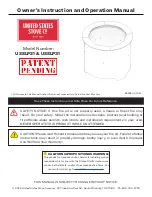
4100-I ACT WOOD INSERT
Page 20
March 27, 2008
R
250-7201 Rev D
MAINTENANCE
CARE AND CLEANING OF PLATED SURFACES
IMPORTANT:
You must clean all the fi ngerprints and oils from the plated surfaces before fi ring the insert for the fi rst time.
Use warm soapy water and a soft rag, glass cleaner and a paper towel, or vinegar and a paper towel to remove the oils. DO
NOT use abrasive cleaners! If not cleaned properly prior to lighting the fi rst fi re, the oils can cause permanent stains. The
plating will be cured upon fi ring of the insert and oils will no longer affect the fi nish. Subsequently, little maintenance is then
required. Wipe clean as needed with a soft towel.
CARE AND CLEANING OF GLASS
NOTE: Remove all labels from glass prior to lighting the fi rst fi re.
Quadra-Fire inserts are equipped with super heat resistant ceramic glass which can only be broken by impact or misuse.
Clean glass with any non-abrasive glass cleaner. Abrasive cleaners may scratch and cause glass to crack. Inspect glass
regularly. If you fi nd a crack or break, immediately put the fi re out and return the door to your authorized dealer for replace-
ment of glass before further use. Do not substitute materials for glass replacement.
GLASS REPLACEMENT INSTRUCTIONS
Replace with 5mm ceramic glass only
1. Remove door from insert and lay on a padded fl at surface.
2. Remove glass retainer screws using a Phillips screwdriver.
3. Lift glass out of the door frame and/or side frames.
4. Lay new glass with fi berglass tape around it into door frame and/or side frames.
5. Place glass retainers over the fi berglass tape on the edges of the glass and re-install screws. Be sure glass
is centered in the opening (i.e. same space top and bottom, left and right).
6. Tighten screws enough to hold frame and glass in place.
7. Check again for centering of glass in door and/or side frames and give all screws a fi nal tightening.
CREOSOTE FORMATION AND NEED FOR REMOVAL
When wood is burned slowly it produces tar and other organic vapors which combine with expelled moisture, and, in turn
forms creosote. These creosote vapors condense in the relatively cool chimney fl ue when a fi re is newly started, or from a
slowly burning fi re, and accumulate on the fl ue lining of the chimney.
A build up of creosote can then be ignited by sparks rising up the chimney. When ignited, this situation makes an extremely
hot fi re which may damage the chimney and even destroy your home. The chimney connector and chimney should be
inspected at least once every two months during the heating season to determine if a creosote buildup has occurred. It is
extremely important that this residue is removed at regular intervals, usually once a year depending on your burning habits,
to prevent the occurrence of a chimney fi re. It is highly recommended that you contact a professional chimney cleaner for
this area of maintenance.
CHIMNEY
If your type of installation involves a full reline of the chimney, it will be necessary to either remove the baffl e from the insert,
or remove the insert from the fi replace and disconnect the vent prior to cleaning the chimney. Refer to
page 20
in this
manual for instructions on Baffl e Removal.
If your type of installation is direct connect within a masonry chimney, the insert will need to be pulled out from the fi replace
and disconnected from the fl ue prior to cleaning the chimney. The creosote can either be caught in a large garbage bag
secured to the pipe or swept and vacuumed out of the fi replace. Reconnect the pipe and re-install the insert following
installation instructions in this manual on
page 9.
WARNING! DO NOT CLEAN GLASS WHEN HOT.
WARNING! DO NOT SLAM INSERT DOOR OR
IMPACT THE GLASS WHEN CLOSING THE DOOR,
MAKE SURE THAT LOGS DO NOT PROTRUDE
AGAINST THE GLASS.
WARNING! DO NOT OPERATE WITH BROKEN
GLASS.









































